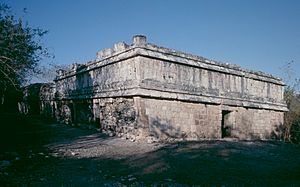Akab Dzib facts for kids
The Akab Dzib is an ancient building at Chichen Itza, a famous Maya archaeological site. It's located in the Yucatán Peninsula in Mexico. This special building gives us clues about the amazing Maya people who lived there long ago.
Archaeologists formally call this building Chichen Itza Structure 4D1. You might also see its name spelled as Akab Tzib or Akabdzib. In modern Maya writing, its name is Akab' Tz'ib' or Akab' Tz'iib'.
Contents
What Does Akab Dzib Mean?
The name "Akab Dzib" comes from the Maya language. It means "The House of Mysterious Writing." This is because of some cool carvings found inside.
Long ago, this building had another name: Wa(k)wak Puh Ak Na. This means "the flat house with many rooms." It was likely the home of an important leader named kokom Yahawal Cho' K’ak’, who helped manage Chichen Itza.
Exploring the Akab Dzib Building
The Akab Dzib is not super tall, only about 6 m (20 ft) high. But it's quite long, stretching about 50 m (160 ft), and 15 m (49 ft) wide.
Building Features
- Doorways: The side facing west has seven doorways. The side facing east has only four doorways. A big staircase on the east side leads up to the roof. This east side was probably the main front of the building.
- Cenote View: The front of the building looks out over what is now a dry, but steep, cenote. A cenote is a natural pit or sinkhole, often filled with water, that was important to the Maya.
- Mysterious Writings: At the south end of the building, there's one entrance. This door opens into a small room. On the wall opposite the entrance, there's another doorway. Above this doorway, on the stone beam called a lintel, are detailed carved symbols called glyphs. These are the "mysterious" writings that give the building its name!
- Carved Figures: Below the lintel, in the doorframe, there's another carved panel. It shows a seated figure surrounded by even more glyphs.
- Handprint: Inside one of the rooms, close to the ceiling, you can find a painted handprint. It's a small detail that makes you wonder who left it there!
Restoration Efforts
The INAH, which is Mexico's National Institute of Anthropology and History, worked to restore this building. They finished their important work in 2007, helping to preserve this ancient structure for future generations to explore and learn from.


